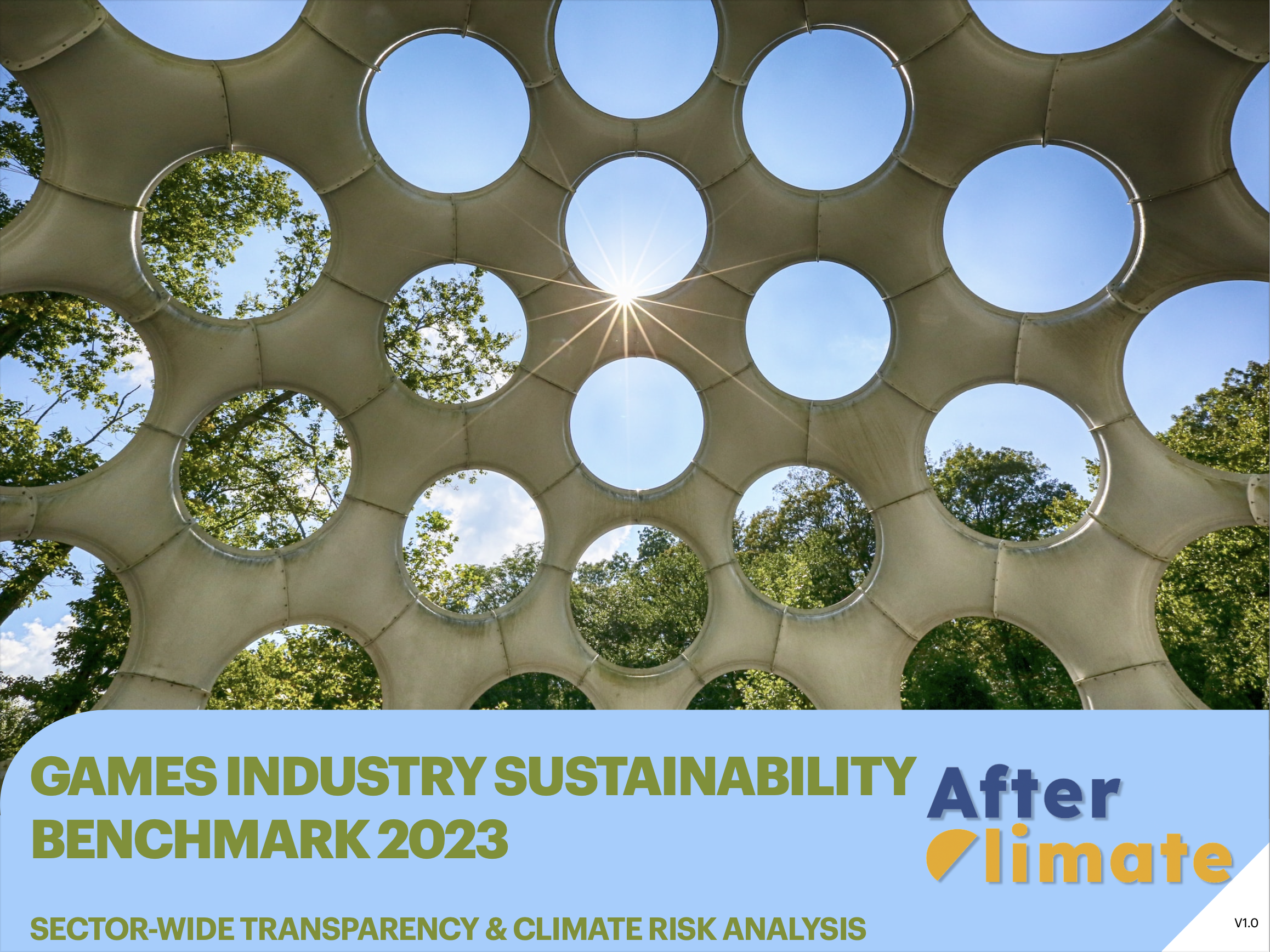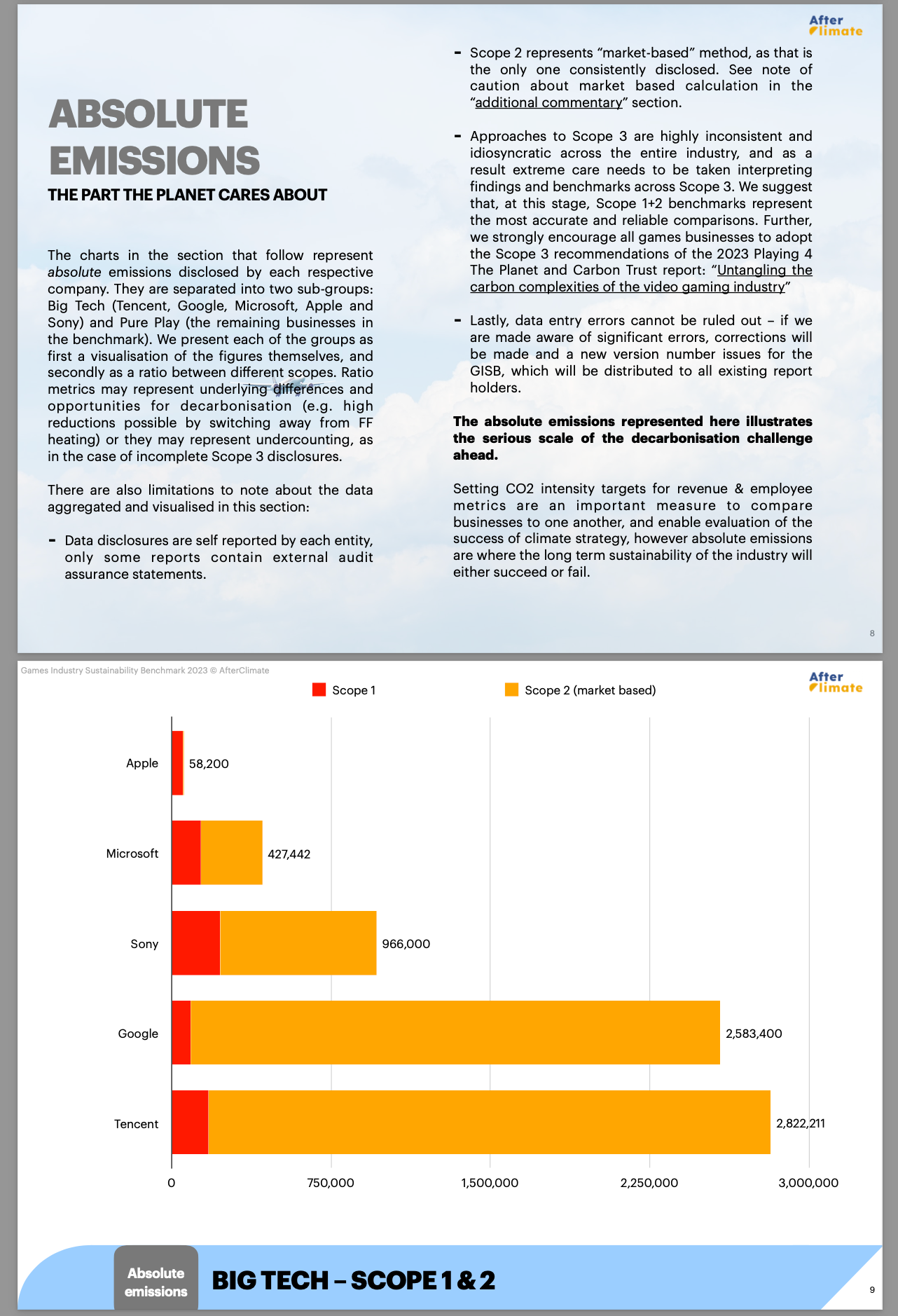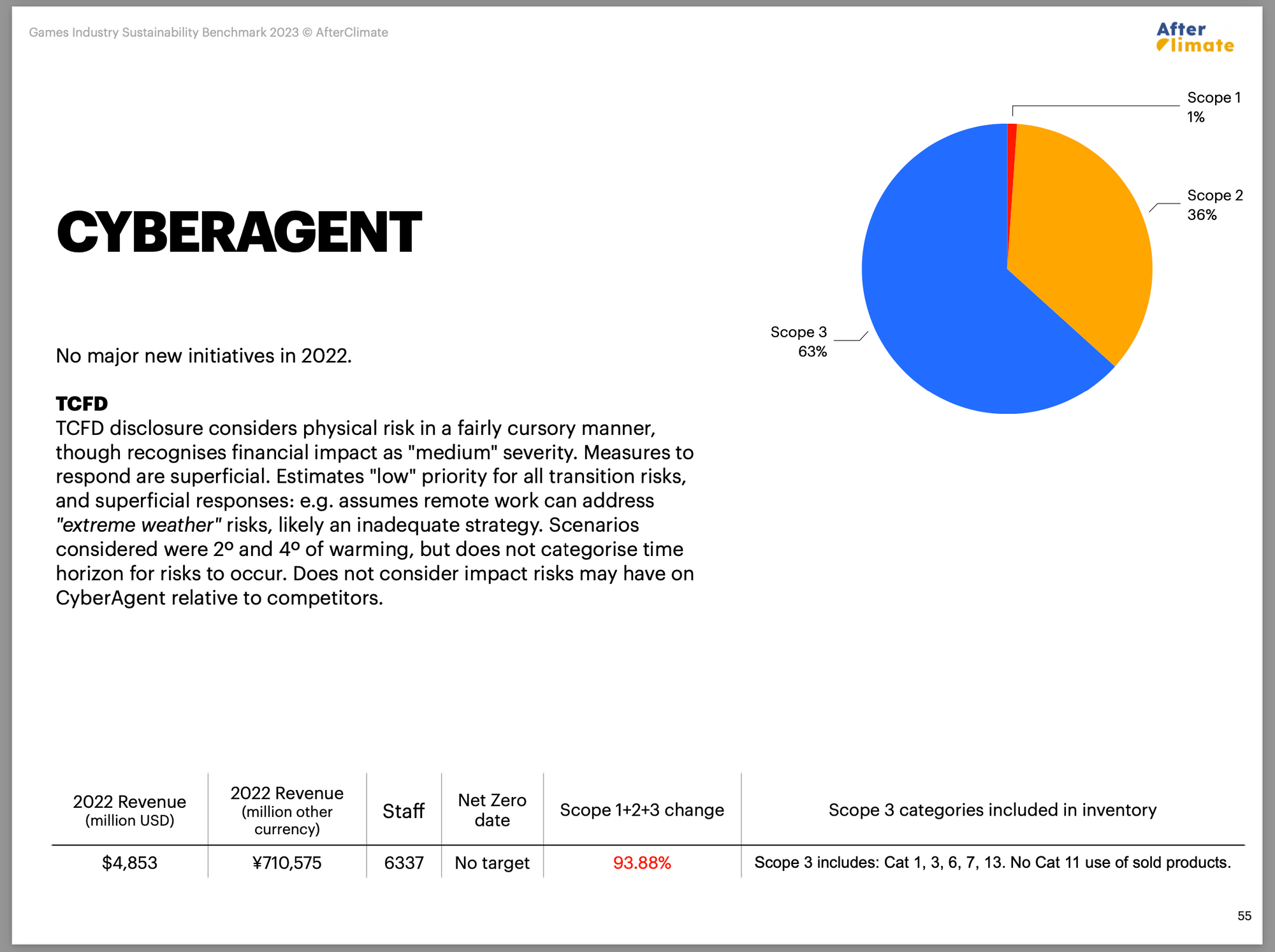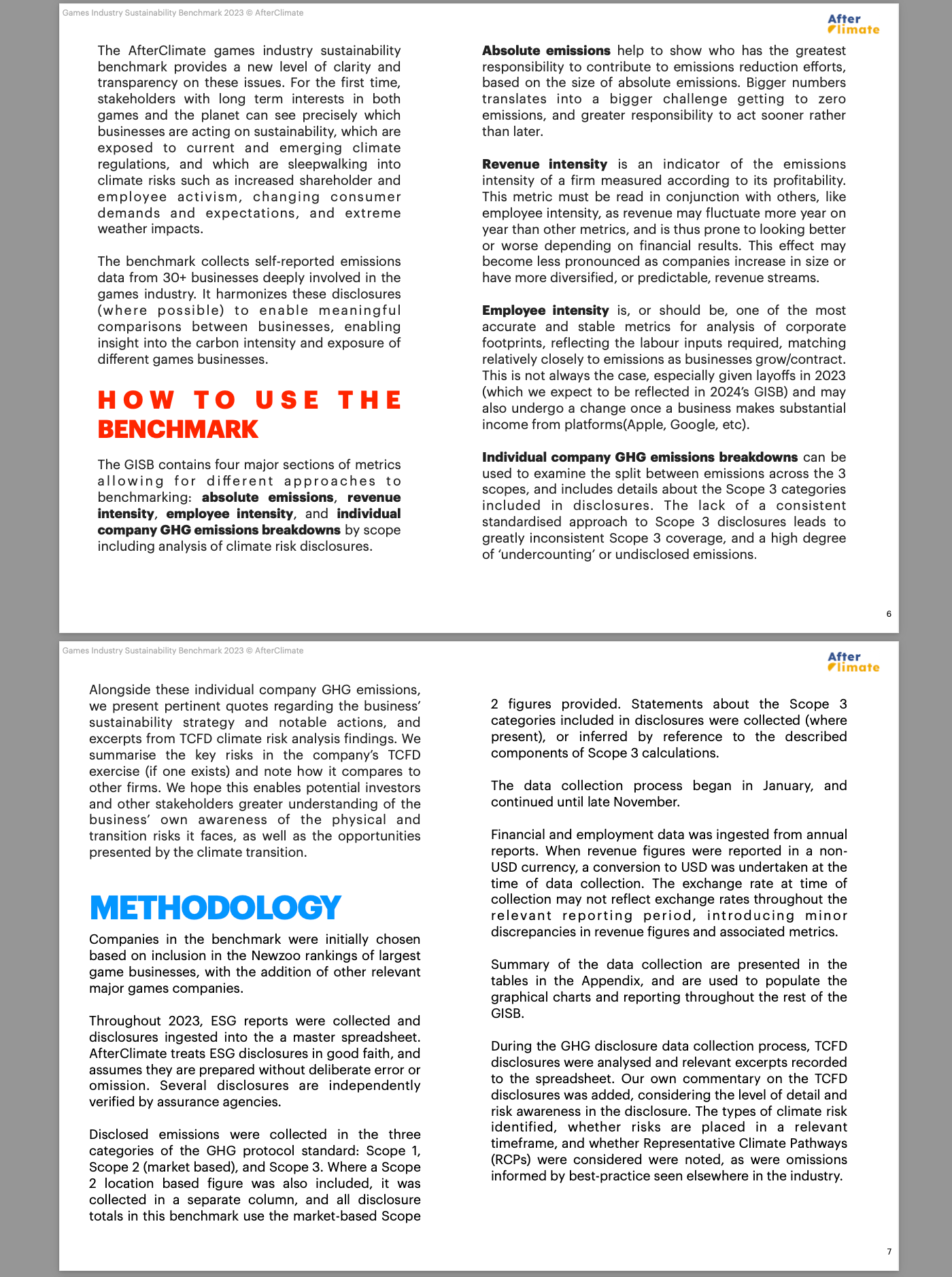Now Available: AfterClimate's flagship report, The Game Industry Sustainability Benchmark 2023

I believe having good data about where, why, and how emissions are occurring across the games industry is a necessary first step in enabling effective action to reduce those emissions. You can’t manage what you can’t measure.
It is in keeping with that approach that I am super pleased to announce AfterClimate’s brand new flagship report – the Games Industry Sustainability Benchmark for 2023, is now available for purchase. What is it, and why is it worth grabbing a copy? Think of it as the ‘net zero snapshot’ on steroids. It’s all the data I have collected from across the entire year’s ESG disclosures, digested, packaged and presented in a highly accessible way. The GISB23 makes abundantly clear who is doing what exactly, what risks the industry is facing from new legislation, what initiatives are having success at delivering decarbonising for their business, and who is aware of the climate risks they are likely to face (physical risk and transition risks) over the coming years and decades.
Some of the key features of the report are:
- Scope 1, 2 and 3 disclosures from 30+ of the biggest games businesses.
- Side-by-side visualisations and ranking of game businesses according to GHG intensity by:
- Absolute emissions totals (both Scope 1+2 and Scope 1+2+3)
- Revenue intensity metrics (GHG per $1m USD – Scope 1+2, and Scope1+2+3)
- Per employee intensity metrics (GHG per head – Scope 1+2, and Scope 1+2+3)
- Sophisticated multi-variable chart of GHG emissions scale, located according to revenue & employee numbers – the most illustrative comparative visualisations of impacts to date.
- Overview of decarbonisation strategy from industry sustainability leaders, applicable to other large games businesses.
- Summaries of key metrics and observations by AfterClimate drawn from the GHG comparative exercise.
- 33 Individual company profiles with ESG data breakdowns, year-on-year emissions changes, summaries of announced sustainability initiatives, plus analysis and commentary on TCFD risk disclosures.
- Table of climate disclosure legislation being considered and implemented in major jurisdictions including timelines and analysis of which games businesses are likely to face new disclosure burdens.
- Plus some bonus visualisation of differences between Scope 2 calculation methods and the evolving consensus on market- vs location-based calculations and additionality considerations.
Here are some early pages to give you a sense of it.

It's designed to enable readers to flick back and forth between pages, to see for instance how ratios and rankings change when moving from Scope 1 & 2 reporting to Scope 1, 2 & 3. It’s clear from the report that the conclusions from the recently released Playing 4 the Planet & Carbon Trust report on Scope 3 are sorely needed, to ensure meaningful comparisons and benchmarks, and to fully and truthfully capture the global footprint of the industry. I’ve taken great care to emphasise where think Scope 3 exclusions are affecting the picture, with a list on each company profile page of which Scope 3 categories are included in the disclosed figures.
Each of the report’s visualisations separates companies reported on into ‘Big Tech’ and 'Play' focussed businesses to enable meaningful comparisons and more illustrative visualisations.
Think of the whole 83-page document as a highly organised and structured download of the most salient sustainability data, the most useful comparisons, details of the most impactful initiatives, and all the analysis that AfterClimate has gathered and conducted this year. I have dedicated hundreds of hours to this project over the year, to maintain a high level of detail while still enabling real transparency. There’s something in here for nearly everyone who works in or makes decisions that touch on the sustainability of a games business.
I hope it will be useful for games ESG professionals in particular. If you are looking for ways to compare your business’ environmental metrics against peers, this is the place to start. I hope the report – produced entirely independently of any of the games businesses included – also supplies important context for sustainability initiatives, and (ideally) ammunition for credible communications to stakeholders about why and how games businesses are choosing to prioritise their time and effort, and conveys emerging best practices across the industry. I am confident there will be something useful for most games businesses, to inform their next round of ESG disclosures, as well as for investors looking to choose where to allocate capital.

All owners of a copy of the report can request access to the raw data behind any of the charts, allowing for styling them to match specific corporate branding and future disclosures.
Here’s a look at pages 6 and 7 with suggestions for how the report can be used for GHG benchmarking.

Games are big business, even with the disruptions from layoffs and the uncertainty of funding that has been plaguing the industry this year. Institutional investors are still interested in a slice of the pie, and for investors with a truly long-term vision, the GISB provides an entirely independent assessment of corporate efforts, and new visibility on the industry’s leading lights, their climate strategies and results. I hope that it provides guidance and can support directing sustainability-minded investors towards more sustainable game businesses, and indicate how their investments are performing in relation to the broader industry.
The report may also be of interest to researchers and government bodies looking to get an overview of the scale of the GHG impacts and tailor their industry support in ways that enhance long-term sustainability and accelerate decarbonisation of the world’s biggest entertainment industry. For governments aiming to support national industries through tax incentives and subsidies, awareness of sustainability criteria and the performance of those receiving this support may prompt new engagements, to shore up Nationally Determined Contributions, and ultimately national net-zero targets.
Every purchase of the report comes with a free 1-hour consultation with me where you will have the opportunity to ask questions, discuss the report and its implications, and get my interpretation of its most relevant aspects for your situation.
Here’s a peek at the table of contents:

The report designed for game businesses and professionals who want to know where their company stands amongst the sustainability leaders (and the laggards) of this global industry.
The report is available for $2200 (USD) including GST. You can use this link to purchase the report (checkout via Stripe and accepting all major cards and some bank transfers) and you should receive an email containing the PDF within a few minutes.
If you have any questions about it, or are not sure if it contains exactly what you're looking for – shoot me an email and I’ll be happy to chat.
I am extremely proud of the work that’s gone into this – it has been a mammoth task. I hope it has a similar sized impact.